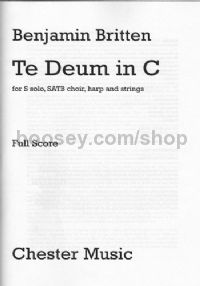Te Deum In C (Full Score)
Te Deum In C (Full Score)
* Estimated price converted from UK retail price
The full score of Benjamin Britten's Te Deum In C, for SATB choir, soprano solo, harp and strings.
In preparing for publication the 1935 orchestral version of Britten's Te Deum in C, it became clear that there were a number of discrepancies between the manuscript and the original 1934 vocal score. Some of these were minor: different articulation and dynamic markings, something Britten was later very fussy about, but perhaps left unchanged on proof because of his relative inexperience at this stage of his career with the processes of music publishing. Others were more important: wrong pedal notes, for example, which Britten failed to notice on proof, and which have been perpetuated in performances and recordings for nearly seventy years. These have been corrected in the new edition of the vocal score and in the orchestral score (Britten clearly used the published vocal score to prepare his orchestral version). The two versions have been made consistent in other details - rehearsal cues and bar numbers, for example - since Britten intended choristers to use the vocal score to perform the orchestral version. This would have been an easy task, for these is little discrepancy in essential details between versions (a rare departure occurs in bars 53 to 56, where the works 'Lord God of Sabaoth' are unaccompanied in the orchestral version, but doubled by Organ in the original). Sustained Organ chords are often filled out with arpeggiated string writing, while the spacing of chords is frequently much wider in the string version, with melodies transposed into different octaves. Although harmony in both versions is identical, voice leading is sometimes altered in the latter to make it better suited to the idioms of the instruments concerned.
So, although in essence the two versions are the same, the soundworld explored in each is quite distinct. Britten's orchestral version should neither be viewed as an occasional piece nor considered solely a liturgical work, like many of his choral pieces from the 1930s and 1940s, it is equally at home in church and concert hall.




